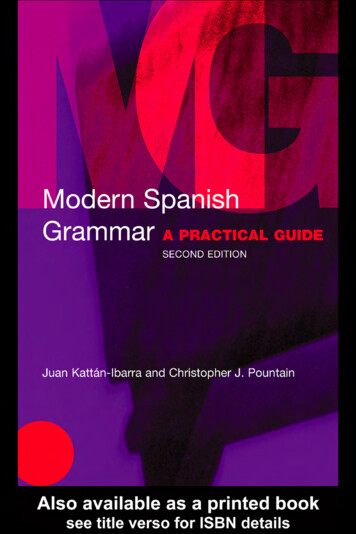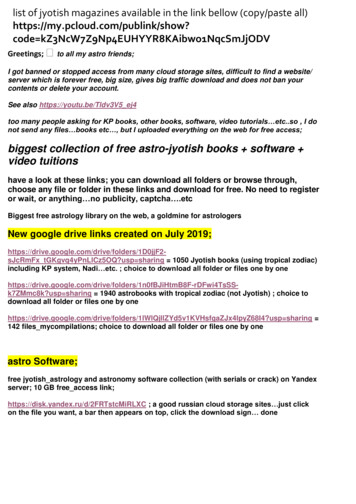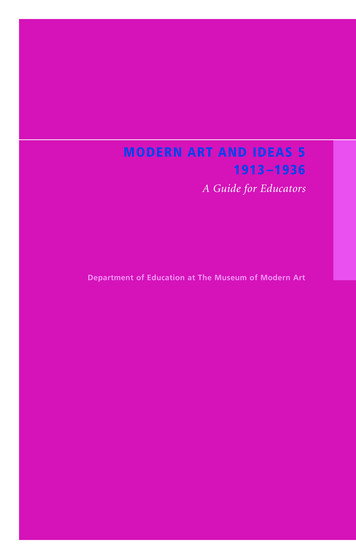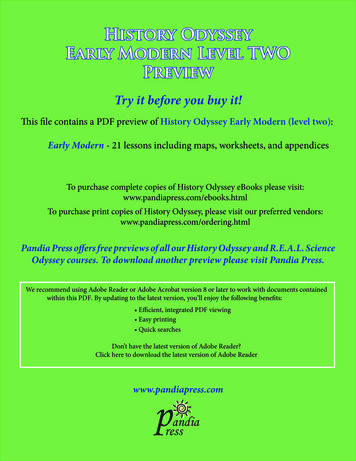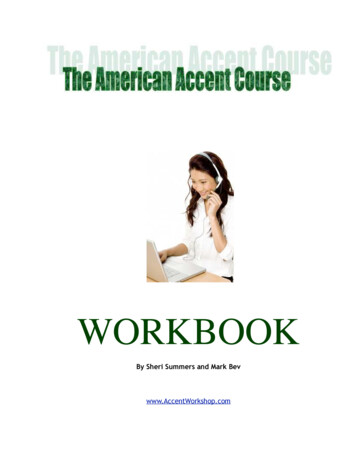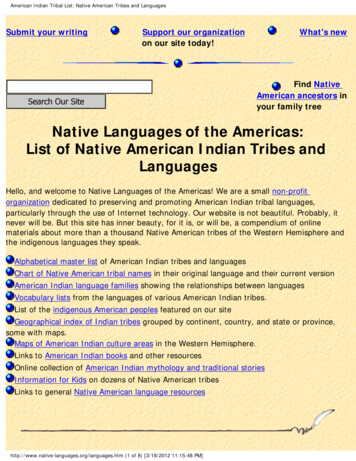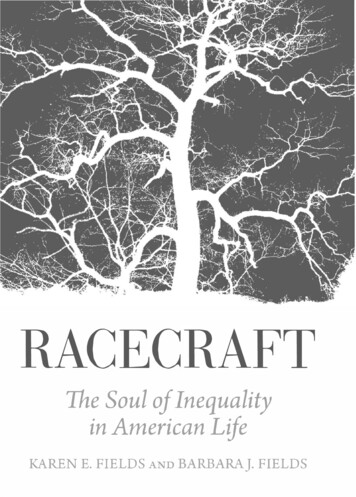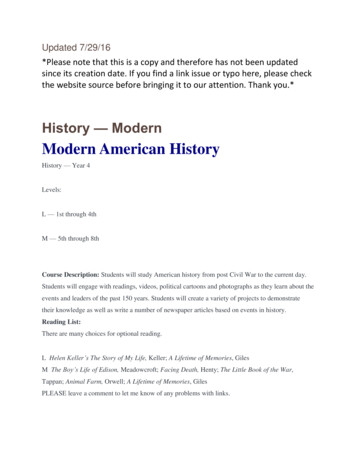
Transcription
Updated 7/29/16*Please note that this is a copy and therefore has not been updatedsince its creation date. If you find a link issue or typo here, please checkthe website source before bringing it to our attention. Thank you.*History — ModernModern American HistoryHistory — Year 4Levels:L — 1st through 4thM — 5th through 8thCourse Description: Students will study American history from post Civil War to the current day.Students will engage with readings, videos, political cartoons and photographs as they learn about theevents and leaders of the past 150 years. Students will create a variety of projects to demonstratetheir knowledge as well as write a number of newspaper articles based on events in history.Reading List:There are many choices for optional reading.L Helen Keller’s The Story of My Life, Keller; A Lifetime of Memories, GilesM The Boy’s Life of Edison, Meadowcroft; Facing Death, Henty; The Little Book of the War,Tappan; Animal Farm, Orwell; A Lifetime of Memories, GilesPLEASE leave a comment to let me know of any problems with links.
Materials: Basic Supplies History, Year 4, Level LGeorge Washington Carver, The Transcontinental RailroadDay 1L1. Read biography of George Washington Carver2. Tell a parent or older sibling about George Washington Carver’s life. How many things canyou remember?M1. Watch animation about the Growth of the Nation for review and preview (click on play)2. *Color a map of the USA to show what states belonged the United States at the end of theCivil War. (Click on USA with Alaska and Hawaii and 1 page and then print.)Day 2L**1. Watch George Washington Carver video.2. *Print out these Timeline Decade Pages. You can put them in a notebook or on the wall.They are for your timeline pieces.3. *Print out the modern history timeline packet.4. Cut out Carver timeline piece and draw or write about Carver inside. Attach it to yourtimeline.M**1. Read short biography of George Washington Carver2. *Print out these Timeline Decade Pages. You can put them in a notebook or on the wall.They are for your timeline pieces. (L is using this too.)3. *Print out the modern history timeline packet (L is using this too). Cut out timeline piece andwrite about Carver. Attach it to your timeline.
4.If you are an advanced reader and want to learn more, there is a biographical book onCarver you can read for fun.Day 3L*1. Watch the video on the transcontinental railroad.2. Write: The Transcontinental Railroad means a railroad that travels across a continent.(*You could use your timeline piece or create a *handwriting page.)3. continental means something related to a continent, a continent is one of the seven largeland areas on earth, trans means across.M1. Play Railroad Race — On one page it tells you to read a paragraph, but when you click thelink, it’s not there. Here are pictures of the three places listed. Which has what the railroadneeds? The Badlands The Sandhills The North Platte River Valley2. In the middle you’ll have to choose which company you will work for, click on one. Don’tworry when it tells you to research the Indians or make a project. Just keep clicking. Youshould try to answer the questions though.Day 4L*1. Find Sacramento, California and Omaha, Nebraska on a map. These were the start and endpoints of the first transcontinental railroad.2. *Draw a line on a map, as best you can, of where the railroad traveled. (click on UScontinental, 1 page, print)3. Place the map in your history notebook.M*
1. Move cursor over photos to read about the people. Click to read more.2. *Print out map and label each route with the name of the man in charge of that railroad.3. Cut out the transcontinental railroad piece. Write inside about the railroad inside and place onthe 1860s page of your timeline. Or if you don’t like little booklets, you can just cut out thepicture and attach it to the page and write on the paper.Day 51. L and M Read the News. Write an email to someone and tell them about what you read inthe news.Alexander Graham Bell, Thomas EdisonDay 6(*)L(*)History(*)1. Watch this movie about Alexander Graham Bell.2. If that video is not available, watch this video clip about Alexander Graham Bell and *choosesome activities to complete from this packet. (On Day 7 they will do pages 10 and 40.)M1. Watch 30 minute movie about Alexander Graham Bell.Day 7L*1. Read this biography of Alexander Graham Bell2. *Print pages 10 and 40 and any others you like. Answer the questions on page 10 and page40 as best as you can. You can check your answers on page 46 to learn more about Mr. Bell.3. Cut out timeline piece and write inside about Alexander Graham Bell. What were hisaccomplishments? What did he care about?M
1. Read biography of Alexander Graham Bell. It continues on this page. You can click on thepictures to see them bigger.2. Write about his life. What do you admire about him? What were his accomplishments? Whatdid he care about? Use the piece from the timeline to write inside.3. Look at these different diagrams of how to build a telephone like Bell’s. We hear soundbecause of vibrations. Your voice creates the vibrations. Mr. Bell figured out how to turnthose vibrations into bursts of electricity that travel through the wires. Diagram one Diagramtwo It’s not so complicated, is it? His big discovery was how liquid, specifically an acid(like vinegar), made the vibrations stronger and clearer. In science this year we will learnmore about acids, electricity, vibrations and sound.Day 8L1. Read biography of Edison2. Cut out and write in Edison’s timeline piece and add it to your timeline.M1. Read chapter 1 and 2 of The Boy’s Life of Edison2. Write a summary of each chapter in a sentence or two. Type them onto a power point slidefor each chapter. Record your voice reading the slide. You can get some pictures for some ofyour slides from Wikipedia.Day 9L*1. *Copy Edison’s quote. Then explain what it means. Print out — Edison Quote NotebookingPage. (The quote was made in 1903 and published in Harper’s Monthly in 1932.)2. Watch the videos below and look at the list of all of Edison’s inventions.M one two
1. Read chapter 3 and 4 of The Boy’s Life of Edison2. Write a summary of each chapter in a sentence or two. Make a power point slide for eachchapter. Record your voice reading the slide.Day 10L1. Read the News (alternate news site) Tell someone about what you learned in the news today.2. If you can read fifth grade level books and are interested in Edison, you could read this storyof his life, The Boy’s Life of Edison.M1. Read a news article. Tell someone about what you learned in the news today.2. Read chapter 5 and 6 of The Boy’s Life of Edison3. Write a summary of each chapter in a sentence or two. Make a power point slide for eachchapter. Record your voice reading the slide.Day 11L1. Watch this video about Thomas Edison. Here’s an alternate link if that one disappears.2. If those disappear on us, here are some alternatives.M1. Read chapter 7 and 8 of The Boy’s Life of Edison2. Write a summary of each chapter in a sentence or two. Make a power point slide for eachchapter. Record your voice reading the slide.Day 12L1. Answer these questions as best you can about when Thomas Edison invented the light bulb.If you know how to type, then type your answers into the computer. Who? What? Where?
When? How? Why? For instance who is Thomas Edison or Edison and Watson. What is thathe invented the light bulb. These are the questions you ask and answer when you write astory for the newspaper.M1. Read chapter 9 and 10 of The Boy’s Life of Edison2. Write a summary each chapter in a sentence or two. Make a power point slide for eachchapter. Record your voice reading the slide.Day 13L1. Write a sentence to introduce a news story about Edison inventing the light bulb. (Example–don’t copy!–Thomas Edison invented many things, but one changed the world the most.) Putthese sentences in the same place you put your answers from yesterday.2. Write a sentence about what you think about Edison or his invention. (Example–don’t copy!–I think Edison’s hard work paid off.)M1. Read chapter 11 and 12 of The Boy’s Life of Edison2. Write a summary of each chapter in a sentence or two. Make a power point slide for eachchapter. Record your voice reading the slide.Day 14L1. Write your news story. Start with your introduction sentence. Then write in sentences youranswers to the who, what, where, when, why and how questions. Then write your finalsentence. If you have time, add a title and a picture. Show it to someone.M1. Read chapter 13 and 14 of The Boy’s Life of Edison
2. Write a summary each chapter in a sentence or two. Make a power point slide for eachchapter. Record your voice reading the slide.Day 15L1. Read the News (alternate news site). Choose an article and write (or tell someone) the who,what, where, when, why and how of it.M1. If you have younger siblings, read their news articles on Edison.2. Read chapter 15 and 16 of The Boy’s Life of Edison3. Write a summary of each chapter in a sentence or two. Make a power point slide for eachchapter. Record your voice reading the slide. Show your presentation to your family. (Youcan read the rest of the book on your own if you like.)4. Cut out your Edison timeline piece and add it to your timeline. Write inside!Helen Keller, Industrial Revolution (Coal Mines)Day 16L1. Read this short biography of Hellen Keller. It mentions the book she wrote. You are going tobe reading it. And you can start now.2. Read chapter 1 of The Story of My Life: Helen Keller. If you cannot read it on your own(that’s okay, it’s not easy), you can listen while you read along. Or you don’t have to read atall, just sit back and listen. Go to the “listen” link and click on chapter 1.3. Tell someone about Helen Keller.M1. Photos from the coal mines: one, two, three2. Watch this video about coal mining today.3. About coal mining:
Coal was needed in vast quantities for the Industrial Revolution. For centuries, people inBritain had made do with charcoal if they needed a cheap and easy to acquire fuel. What‘industry’ that existed before 1700, did use coal but it came from coal mines that were nearto the surface and the coal was relatively easy to get to. The Industrial Revolution changedall of this.Before the Industrial Revolution, two types of mines existed : drift mines and bell pits. Bothwere small scale coal mines and the coal which came from these type of pits was usedlocally in homes and local industry.However, as the country started to industrialise itself, more and more coal was needed tofuel steam engines and furnaces. The development of factories by Arkwright and theimprovement of the steam engine by Watt further increased demand for coal. As a resultcoal mines got deeper and deeper and coal mining became more and more dangerous.Coal shafts could go hundreds of feet into the ground. Once a coal seam was found, theminers dug horizontally. However, underground the miners faced very real and greatdangers. Flooding was a real problem in mines. Explosive gas (called fire damp) would befound the deeper the miners got. One spark from a digging miner’s pick axe or candle couldbe disastrous. Poison gas was also found underground and pit collapses were common; thesheer weight of the ground above a worked coal seam was colossal and mines were onlyheld up by wooden beams calledprops. (from http://www.historylearningsite.co.uk/coal mines industrial revolution.htm)1. Read chapters 1 and 2 of Facing Death Parents: If this is too much reading, you can take out this book.Day 17L1. Read chapter 2 of The Story of My Life: Helen Keller. If you need help, you canlisten whileyou read along. Just click on the chapter number.2. Here are pictures of Hellen Keller to look at.M*1. Read chapters 3 and 4 of Facing Death
2. Industrial Revolution — coal was an important part of running all these new factories.Farming was no longer the main economy of the country. We were producing more fromfactories now and coal was the fuel for those factories. Here’s a picture of kids working in amine.3. Use this Coal mines notebooking page to write as if you were a worker in a coal mine. Usewhat you’ve learned about coal mines and the time period and write a paragraph about yourlife as a coal mine worker. Use the blank box for your title.Day 18L*1. Read chapter 3 of The Story of My Life: Helen Keller If you need help, you canlisten whileyou read along. Just click on the chapter number.2. *Use this Helen Keller notebooking page. Copy the quote. Use the other space to write whoHelen Keller was.M1. Read chapters 5 and 6 of Facing Death2. Watch this video on the industrial revolution.3. Interview a younger sibling who is learning about Helen Keller or read this short biography.Day 19L1. Read chapter 4 of The Story of My Life: Helen Keller If you need help, you canlisten whileyou read along. Just click on the chapter number.2. Watch this video on the industrial revolution. Tell someone about how life changed forAmericans.M1. Watch this video on the industrial revolution. Write in your notebook what an agrariansociety is and what an industrial society is. Also write what technology made the industrialrevolution possible.
2. Read chapters 7 and 8 of Facing Death.Day 20L1. Read the News (alternate news site). Choose an article and write (or tell someone) the who,what, where, when, why and how of it.2. Read chapter 5 of The Story of My Life: Helen Keller If you need help, you canlisten whileyou read along. Just click on the chapter number.3. Maybe over the weekend you’d like to watch this 20 minute animated movie about HelenKeller. Here’s the link to the first part on youtube. Get permission to watch this!M1. Read a news article. Write out or tell someone the answers to the journalist’s questions: who,what, where, when, why and how.2. Read chapters 9 and 10 of Facing Death.Henry Ford, Child Labor, Suffrage MovementDay 21L1. Read chapter 6 of The Story of My Life: Helen Keller If you need help, you canlisten whileyou read along. Just click on the chapter number.2. Read this biography of Henry Ford.3. Cut out and fill in Henry Ford timeline piece.M1. Read chapters 11 and 12 of Facing Death.2. Read this biography of Henry Ford.3. Cut out and fill in Henry Ford timeline piece.Day 22L
1. Read chapter 7 of The Story of My Life: Helen Keller If you need help, you canlisten whileyou read along. Just click on the chapter number.2. Look at these pictures of child labor in America. Choose a picture and show it to someoneand describe to them what you see. What are they doing? Why do they look the way they do?What do you think they are thinking and feeling? Write your answers or talk with a parent orolder sibling about your answers.M1. Read chapters 13 and 14 of Facing Death.2. Read this page about child labor in America and look at the pictures. Lewis Hine was aphotojournalist. He exposed child labor for what it really was and helped bring aboutreforms. Write in your notebook what you find most shocking.Day 23L1. Read chapter 8 of The Story of My Life: Helen Keller If you need help, you canlisten whileyou read along. Just click on the chapter number.2. Do this activity about learning by looking at old photographs.M1. Read chapters 15 and 16 of Facing Death.2. Look at these photographs. Make observations and conclusions. Write about the suffragettesfrom what you’ve observed. Here’s a women’s suffrage notebooking page. photo 1 photo2 photo 3 photo 4Day 24L1. Read chapter 9 of The Story of My Life: Helen Keller If you need help, you canlisten whileyou read along. Just click on the chapter number.2. Look at this old photograph of suffragettes. What details do you see this photograph? Whoare the suffragettes? What do they want? (answer: the right to vote) How badly do you think
they want it? (hint: check the weather) Write in your history notebook a sentence about thesuffragettes. “The suffragettes were ” You finish the sentence.M1. Read chapters 17 and 18 of Facing Death.2. Read this short article about the suffragette movement. How much of this information didyou get from looking at the pictures yesterday? Add to or edit your writing from yesterdayfrom what you learned today.Day 25L1. Read the News (alternate news site). Choose an article and write (or tell someone) the who,what, where, when, why and how of it.2. Read chapter 10 of The Story of My Life: Helen Keller If you need help, you canlisten whileyou read along. Just click on the chapter number.M1. Read a news article. Write out or tell someone the answers to the journalist’s questions: who,what, where, when, why and how.2. Read chapters 19 and 20 of Facing Death.Theodore Roosevelt, ImmigrationDay 26LReading1. Read this biography of Theodore Roosevelt.2. Read chapter 11 of The Story of My Life: Helen Keller If you need help, you canlisten whileyou read along. Just click on the chapter number.Writing
1. Theodore Roosevelt saved a lot of wilderness. He protected it to keep people from using theforests, rivers, etc. for business or for homes. Write about why you think it’s important toprotect nature as it is. You should begin with a introduction sentence, a sentence that tellswhat you are going to write about. For instance ”I think it is very important to protectnature.”M1. Read this biography of Theodore Roosevelt.2. Read chapters 21 and 22 of Facing Death.3. Write a paragraph about why it is important to protect nature. Theodore Roosevelt was anaturalist. He preserved wilderness as national parks so that we have natural spaces free fromhomes and business. (clean air, clean water what other reasons )4. Do you need tips on writing a proper paragraph? topic sentence supporting details closingsentence5. If you like Theodore Roosevelt and want to read more, he wrote an autobiography and thereis a biography about him.Day 27L1. Watch video on immigration.2. Read chapter 12 of The Story of My Life: Helen Keller If you need help, you canlisten whileyou read along. Just click on the chapter number.M1. Watch video on immigration and Ellis Island.2. Read chapters 23 and 24 of Facing Death.Day 28L*1. Read about the Statue of Liberty.
2. Read chapter 13 of The Story of My Life: Helen Keller If you need help, you canlisten whileyou read along. Just click on the chapter number.3. *Color this picture of the Statue of Liberty and/or copy this quote from the Statue of Liberty.M*1. Read this page about the Statue of Liberty including Emma Lazarus’ poem.2. Read chapters 25 and 26 of Facing Death.3. *Print out this notebooking page, Statue of Liberty quote. What is the meaning of this poem?What is its invitation?4. Practice saying this part of the poem out loud. Stand up in front of your family and read thispoem. Say it like you mean it!Day 29L1. Watch this video showing what it was like to build the Statue of Liberty.2. Watch this video about what it was like to come as an immigrant through Ellis Island.3. People came to America to find freedom: freedom to worship God their way, freedom fromdiscrimination, freedom from poverty, and whatever other problem their families werefacing. They were searching for a better life. Were their first experiences better? What do youthink they were thinking of America when they arrived at Ellis Island?4. Read chapter 14 of The Story of My Life: Helen Keller If you need help, you canlisten whileyou read along. Just click on the chapter number.M1. Read these stories about coming to Ellis Island.2. Was life easy for new immigrants? What was it like for them?3. Read chapters 27 and 28 of Facing Death.Day 30*L1. Play City of Immigrants. (You don’t have to complete the whole thing, but I think you’llprobably want to!)
2. Read chapter 15 of The Story of My Life: Helen Keller If you need help, you canlisten whileyou read along. Just click on the chapter number.3. Write or tell about why you think Helen Keller is important.4. Maybe your family would like to watch The Miracle Worker, a Disney movie about HelenKeller. Here’s the link to the first part on youtube. Get permission to watch this!M*1. Finish Facing Death.2. *Fill out a book report form for Facing Death.If you’re looking for more books to read, check out the tons of Alger books listed under level 5.These fit the time period.The Wright Brothers and other flyersDay 31L1. Watch this video on the Wright Brothers.2. If that video disappears, you can watch these animated movie clips about the Wright Brothersand this old-time film.3. Cut out your timeline piece. Draw/write about what you learn.M*1. Read this comic book about the Wright Brothers (you have to click on “Next Page.)2. Watch this short video which I believe is from a flight demonstration in 1908.3. Draw/write about what you learned. Use a notebooking page with a blank top for drawing.Writing1. Read this example of a “persuasive essay.” It means they are writing to convince someone todo something.2. Last week you wrote a persuasive paragraph. Reading this essay, can you think of ways toimprove your paragraph? If you need to, do a little research so you can include some realfacts.
3. Rewrite your paragraph and make it better, include more detail. Make your introduction andconclusion more interesting.Day 32L*1. Read about Amelia Earhart.2. *Write about Amelia Earhart. Amelia Earhart notebooking page3. Read chapter 16 of The Story of My Life: Helen Keller If you need help, you canlisten whileyou read along. Just click on the chapter number.M*1. Read about Amelia Earhart.2. Write about her life. Amelia Earhart Notebooking PageDay 33L1. Read about Bessie Coleman.2. Tell someone about Bessie Coleman.3. Read chapter 17 of The Story of My Life: Helen Keller If you need help, you canlisten whileyou read along. Just click on the chapter number.M1. Read about Bessie Coleman. Write about her life. Bessie Coleman Notebooking PageDay 34L1. Read about Charles Lindbergh. Click “Next Page” to read through all 12 pages of the story.2. Tell someone about Charles Lindbergh.3. Read chapter 18 of The Story of My Life: Helen Keller If you need help, you canlisten whileyou read along. Just click on the chapter number.M
1. Read about Charles Lindbergh.2. Write about his life. Charles Lindbergh Notebooking PageDay 35L1. Read the News (alternate news site). Choose an article and write (or tell someone) the who,what, where, when, why and how of it.2. Read chapter 19 of The Story of My Life: Helen Keller If you need help, you canlisten whileyou read along. Just click on the chapter number.M1. Read the News. Choose an article and write (or tell someone) the who, what, where, when,why and how of it.World War IDay 36L1. Watch this video on airplanes in WWI.2. Read chapter 20 of The Story of My Life: Helen Keller If you need help, you canlisten whileyou read along. Just click on the chapter number.M1. Read about where airplanes went from the time of the Wright brothers OR watch this videoon airplanes in WWI.Day 37L*1. *Print out map (click on Europe). Color in Turkey, Germany, France, Russia, Serbia,Hungary and Austria. Color each a different color and write their names in that color on theback of the map. Your list of colorful names is your map key.2. If you need a map to look at, here is one online.
3. Read chapter 21 of The Story of My Life: Helen Keller If you need help, you canlisten whileyou read along. Just click on the chapter number.M**1. Read chapter 1 of The Little Book of the War.2. *Print out a map (click on Europe) and label the countries and bodies of water mentioned.Create a key if necessary.3. *Also print out 11 copies of your favorite WWI notebooking page and take notes on eachchapter.4. Two books you could consider reading just for fun over the next several weeks (to day 65)are Rilla of Ingleside (audio book) which is about life on the home front and is from the Anneof Green Gables series and Air Service Boys Over Enemy Lines.Day 38L*1. *Print out another map of Europe. (You’ll notice this one is different. This is what thecountry borders looked like in 1914.)2. Write “European Alliances Before WWI.” That just means which countries in Europe werefriends and agreed to help each other.3. Choose two colors.4. With one color, color in France, Britain, Serbia and Russia.5. With the other color, color in Austria-Hungary and Germany.6. Color neatly. Do the best you can.7. Here’s a map to help you. (Again, this is a map of 1914. Countries break up and get smalleror take on other countries and get bigger.)8. Read chapter 22 of The Story of My Life: Helen Keller If you need help, you canlisten whileyou read along. Just click on the chapter number.M*1. Read chapter 2 of The Little Book of the War.
2. Take notes and keep marking your map. This book can be sparse on dates. Here is a concisetimeline to help you out as your read. (Remember, no clicking on ads!)3. *Print out another map of Europe. (This is a map from 1914. Your other one is more modernday.)4. Read this sheet about European Alliances Before WWI and color this map to show thealliances, who was on whose side. Label the map with a title and the date. Work neatly. Doyour best!5. Need help? Here’s a map from 1914.6. When the war starts, this is what the “sides” look like.Day 39L*July 28thAustria declared war on SerbiaAugust 1stGermany declared war on RussiaAugust3rdGermany declared war on France and invaded Belgium. Germany had toimplement the Schlieffen Plan.August4thBritain declared war on Germany1. Look at this chart above. It’s a list of dates of when certain countries declared war on othercountries at the beginning of WWI.2. *Print out another map! Draw on who is declaring war on whom. Maybe you could draw anarrow from Britain to Germany. Draw an arrow for each country declaring war on anothercountry. This all happened in about 8 days in 1914.3. Put a title on your map, “Declares War 1914” might be a good one.4. Read chapter 23 of The Story of My Life: Helen Keller If you need help, you canlisten whileyou read along. Just click on the chapter number.M*1. *Complete this worksheet, WWI political cartoon.2. Read chapter 3 of The Little Book of the War. Take notes.
Day 40* (A book your family might want to read is The Singing Tree. It is not required. It is anaward winning historical fiction novel about WWI. It is 5th grade reading level with an interestlevel of 3rd – 5th grade — according to a website. )L*1. Cut out timeline piece on the assassination of Archduke Ferdinand. Write inside. He wasassassinated in Sarajevo and was next in line to become King in Austria. His murder isconsidered the spark that started the war.2. Read the News (alternate news site). Choose an article and write (or tell someone) the who,what, where, when, why and how of it.3. If you aren’t reading The Singing Tree, you could read one of two other books. These areoptional. These books are harder so you should listen to it read to you or listen as you readalong. There is a book about women and children on the home front which is Rilla ofIngleside from the Anne of Green Gables series. This has an audio book you can listen to.You can read a chapter a day except for a handful of chapters you’ll need to read on theweekends. Or you could read a boy book which does not have an audio book with it. It’scalled, Air Service Boys Over Enemy Lines.You can read a chapter a day.4. *Here’s a book report page to fill out after you finish reading whatever you arereading. WWI Book ReportM*1. Cut out timeline piece on the assassination of Archduke Ferdinand. Write inside.2. Read an article. *Fill in the chart.Day 41L*1. Watch this lesson about countries declaring war in 1914 and 1915.2. *Color a map to match the one in the lesson. Title for the map, “WWI Expands”M1. Watch this lesson about countries declaring war in 1914 and 1915.
2. Label a map to show the sides–who is in which alliance, and label what year each countryjoined the war.Day 42L*1. *Print out this worksheets and cut out the squares. Put them in the order that makes the mostsense. You can glue them down in order on a sheet of plain paper if you want to keep it inyour binder.M1. Complete this lesson on the causes of WWI. Keep clicking on continue. Hit the back button ifyou need to go read something again.Day 43L*1. *Color this picture of a plane from WWI. Why is it called a tri-plane?2. Look at these photos of WWI airplanes.M1. Read chapter 4.2. Read about planes in WWI.3. Write about one of the planes used. You can draw it too if you like (these are notebookingpages with space for drawing). Do you remember that the Wright brothers sold their planedesign to the government to use for warfare?Day 44L*1. *Color this picture of a Canadian soldier in WWI. Read what it says.2. Watch the soldiers in training.M
1. Read chapter 5. Remember to take notes.2. Take a look at the uses of trenches in WWI. Click on the different places in the diagram for apicture and description.3. Take the trenches quick quiz.Day 45L*1. Read the vocabulary on page 4. (Ls are using all but the wordsearch and crossword puzzles.)2. Watch Songs of World War I while you work on task #3 below.3. Do the vocabulary matching on page 9.M*1. Read the vocabulary on page 4. (M is just using pages 4 and 7, although 4 could be readonline.)2. Watch Songs of World War I while you work on task #3 below.3. Do the vocabulary crossword on page 7.Day 46L*1. *Fill in this worksheet on the causes of WWI. The “Triple Entente” was the name given tothe alliance between Britain, France and Russia. So, what countries make up the “TripleAlliance?”M*1. *Fill in this worksheet on the causes of WWI. Answer the questions under “Levels 5 and 6.”Day 47L1. Take a look at this diagram of trenches used in WWI. Click on the different areas of thediagram for pictures and descriptions.2. Draw a diagram of a trench.
3. Read about weapons used in the war.4. Take the weapons quick quiz.M1. Read chapter 6 and chapter 7. Take notes.Day 48L1. Rea
Helen Keller, Industrial Revolution (Coal Mines) Day 16 L 1. Read this short biography of Hellen Keller. It mentions the book she wrote. You are going to be reading it. And you can start now. 2. Read chapter 1 of The Story of My Life: Helen Keller. If you cannot read it on your own (that’



